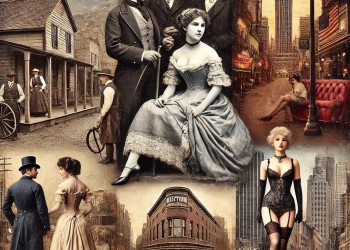The Evolution of Prostitution in America: From Colonial Times to Modern-Day Escort Services

Prostitution, often referred to as the "world's oldest profession," has a long and complex history in the United States. From the early days of America's founding to the present, prostitution has been woven into the fabric of American society, evolving alongside the nation's cultural, economic, and legal landscapes. This blog explores the history of prostitution in America, examining how the profession has changed over the centuries, its social implications, and the current state of the industry.
The Colonial Era: The Beginnings of Prostitution in America
Prostitution has been present in America since the colonial era. During the 17th and 18th centuries, the first European settlers brought with them not only their customs and traditions but also the practice of prostitution. In the early colonies, life was harsh and survival was the priority, leading some women to turn to prostitution as a means of economic survival.
In the colonies, prostitution was largely tolerated, although it was often condemned by religious leaders. Women who engaged in prostitution were generally viewed with disdain, and many were marginalized by society. However, despite the social stigma, prostitution flourished in port cities like Boston, New York, and Charleston, where the influx of sailors and transient workers created a demand for such services.
The 19th Century: Prostitution in the Wild West and Urban Centers
The 19th century saw a significant expansion of prostitution in America, particularly during the westward expansion. The California Gold Rush of 1848 and the subsequent settlement of the American West created new opportunities for prostitution. As men flocked to mining towns in search of fortune, women followed, many of whom worked as prostitutes. In these rough-and-tumble towns, brothels and saloons became commonplace, and prostitution was often tolerated as a necessary outlet for the predominantly male population.
During this period, prostitution was not limited to the Wild West. In urban centers like New York, Chicago, and New Orleans, prostitution was widespread. The development of red-light districts in these cities, such as the infamous Storyville in New Orleans, provided a space where prostitution was openly practiced, albeit with varying degrees of regulation and oversight. These districts were often bustling with activity, with brothels, dance halls, and saloons catering to a diverse clientele.
Estimates of the number of prostitutes in America during the 19th century vary, but it is believed that by the mid-1800s, there were tens of thousands of women working as prostitutes in cities and towns across the country. In New York City alone, it is estimated that there were around 6,000 prostitutes by the 1850s.
The Early 20th Century: The Progressive Era and the Crackdown on Prostitution
The early 20th century marked a significant shift in attitudes towards prostitution in America. The Progressive Era, which spanned from the 1890s to the 1920s, brought about a wave of social reforms aimed at addressing the perceived moral decline in American society. Prostitution became a major target of these reform efforts, leading to increased regulation and criminalization.
The passage of the Mann Act in 1910, also known as the White-Slave Traffic Act, was a key moment in the fight against prostitution. The law made it illegal to transport women across state lines for the purpose of prostitution and was part of a broader effort to combat what was seen as the trafficking of women for immoral purposes.
During this time, red-light districts across the country were shut down, and law enforcement agencies began cracking down on brothels and other establishments associated with prostitution. Despite these efforts, prostitution did not disappear; it simply went underground. Streetwalking and clandestine brothels became more common, and the profession continued to thrive, albeit in a less visible form.
The Mid-20th Century: Prostitution and the Sexual Revolution
The mid-20th century saw further changes in the landscape of prostitution in America. The post-World War II era brought about significant social and cultural shifts, including the rise of the sexual revolution in the 1960s and 1970s. This period was characterized by a more open discussion of sex and sexuality, and with it, a more nuanced view of prostitution.
During the sexual revolution, some feminists argued for the decriminalization of prostitution, viewing it as a legitimate form of work and an expression of women's sexual autonomy. However, this view was not universally accepted, and debates over the morality and legality of prostitution continued.
In the 1970s, the emergence of escort services marked a new chapter in the history of prostitution in America. Unlike streetwalking or traditional brothels, escort services operated in a more discreet manner, often catering to wealthier clients. These services allowed prostitutes to work independently or through agencies, offering a greater degree of control over their work and clientele.
The Late 20th Century to Today: The Modern-Day Escort Industry
As the 20th century drew to a close, the rise of the internet revolutionized the prostitution industry. The advent of online platforms made it easier for escorts to connect with clients, leading to the growth of a more sophisticated and professionalized escort industry. Today, escorts operate in cities across the United States, offering a wide range of services to clients from all walks of life.
The modern-day escort industry is highly diverse, with individuals working independently or through agencies. Some escorts cater to high-end clients, charging thousands of dollars for their services, while others operate in a more traditional manner. The internet has also facilitated the growth of niche markets within the escort industry, with clients seeking out specific types of experiences and services.
Despite the evolution of the industry, prostitution remains a controversial and heavily regulated profession in the United States. While some states and cities have taken steps to decriminalize or legalize certain aspects of the sex work industry, the majority of the country continues to enforce strict laws against prostitution. This has led to ongoing debates about the best way to address the challenges faced by sex workers, including issues of safety, legal protection, and social stigma.
Historical Estimates and Modern Trends
Throughout American history, the number of prostitutes has fluctuated based on economic conditions, social attitudes, and legal enforcement. For example, during the Great Depression of the 1930s, the number of women turning to prostitution increased due to widespread unemployment and poverty.
Today, it is difficult to estimate the exact number of sex workers in the United States, as the industry is largely underground. However, studies suggest that there are hundreds of thousands of sex workers in the country, with a significant number working as escorts. Major cities like New York, Los Angeles, Miami, and Las Vegas are known to have large and active escort markets.
The Social Perception of Prostitution
The social perception of prostitution in America has evolved over time, influenced by cultural, religious, and legal factors. In the early days of the country, prostitutes were often marginalized and viewed as immoral or sinful. This stigma persisted throughout the 19th and early 20th centuries, despite the widespread presence of prostitution in American society.
In recent decades, there has been a growing recognition of the rights and dignity of sex workers. Advocates for sex worker rights argue that prostitution should be decriminalized or legalized to provide greater protection and support for those in the industry. They also emphasize the importance of addressing the underlying social and economic factors that drive people into sex work, such as poverty, lack of education, and limited employment opportunities.
Despite these efforts, sex workers continue to face significant challenges, including legal risks, violence, and social stigma. The ongoing debate over the status of prostitution in America reflects broader societal tensions around issues of morality, sexuality, and personal freedom.
A Complex and Evolving History
The history of prostitution in America is a complex and multifaceted story that reflects the changing dynamics of American society. From the early days of the colonies to the modern era of escort services, prostitution has been a constant, albeit controversial, presence in the United States.
As the nation continues to grapple with questions of legality, morality, and social justice, the future of prostitution remains uncertain. What is clear, however, is that the profession will continue to evolve, shaped by the forces of culture, technology, and the law. Understanding the history of prostitution in America provides valuable insights into the broader social and economic trends that have shaped the country, as well as the ongoing struggles faced by those who work in the industry.
Whether viewed as a moral issue, a matter of personal freedom, or a legitimate form of work, prostitution remains an integral part of America's social fabric—a testament to the enduring complexities of human desire and economic necessity.

I think it's so lame that there was this guy that I would see a occasionally and things would be okay I suppose. The thing that I think is lame is that I went from seeing him occasi...
Read more

Erotic breast and nipple torture, often referred to as CBT (Chest and Breast Torture) or NBT (Nipple and Breast Torture), is a unique and intense fetish that involves the deliberate infliction of p...
Read more

My name is Ts.Sade I'm sexy ts from NY. I'm 31years old 5'ten,1six0lbs,3fourth B.
100% femenine,100% versatile,100%discreet,100% real guranteed to meet the girl in the photo,no f...
Read more



















